Perennial garden tradescantia - planting and growing rules
A bright representative of the Kommelinovye family - garden tradescantia - is a perennial herb. The flower received this name thanks to the son and father of the Tradescants, who brought it to Europe for the first time from the American state of Virginia. Consider what a decorative culture looks like and how to properly care for it.
- Plant characteristic
- Application in landscape
- Description of varieties
- Anderson
- Rosy bride
- Wegelin
- Charm mix
- Virginia
- Striped
- Bilberry ice
- Giant
- Long-rhizome
- Ohio
- Ernestian
- Bracts
- Purchase and adaptation
- Landing
- Growing conditions
- Humidity
- Lighting
- Temperature
- Care
- Watering
- Top dressing
- Pruning
- Preparation for wintering
- Transfer
- Reproduction methods
- Cuttings
- Seeds
- By dividing the bush
- Diseases and pests
- Healing properties
- Useful videos
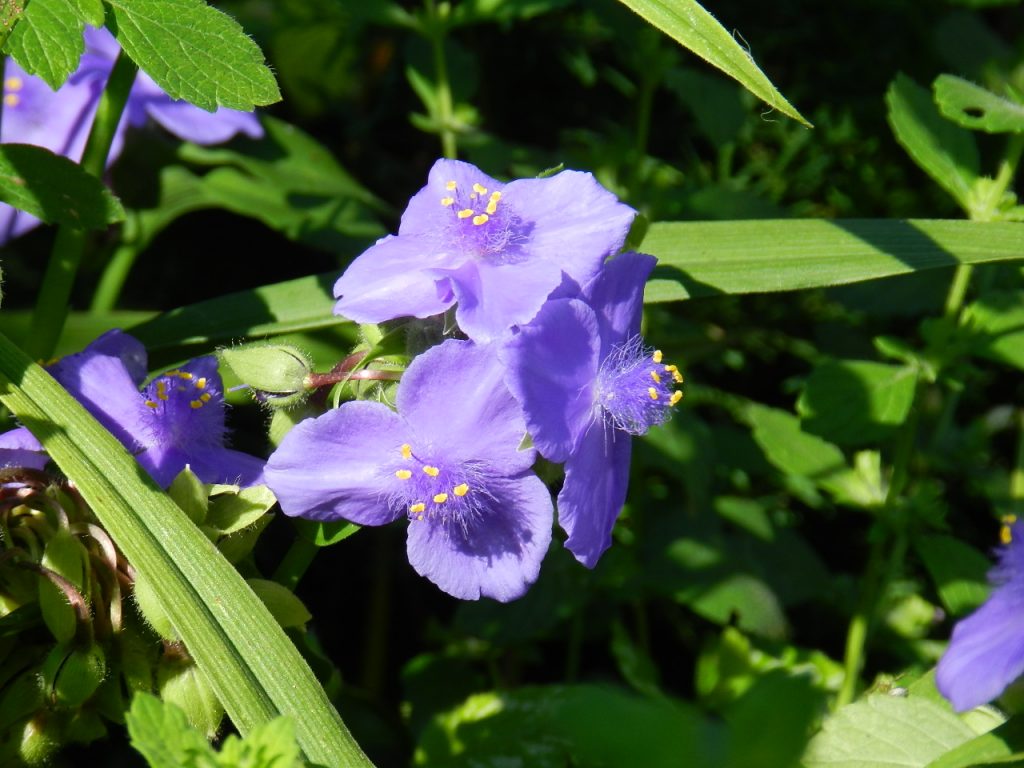
Garden tradescantia photo
Plant characteristic
Shrub plant, reaching 1 m in height at maturity. It has a thickened, fibrous root system, knotty thin stems that grow upward. Ground cover varieties are also found.

Tradescantia photo garden
The leaves, depending on the species, can be of different shades - emerald, light green with purple, yellowish or bluish tint. On the shoots, oval or lanceolate leaves develop alternately.
Umbrella inflorescences appear in the axils of the leaves and at the top of the stems. The flowers are three-lobed, small - the maximum diameter is 5 cm. Depending on the variety, the color palette is extensive - from red to blue. Some varieties delight with two-color flowers.
In the center of the flowers are high, sometimes pubescent stamens. Their decorative effect lasts only a day, the next day new buds open.
Tradescantia has a long flowering period that begins in May and ends in October.
After its completion, seeds appear ripen in small boxes. Later they crack and the seeds shoot in different directions. Therefore, the plant in the wild reproduces successfully by self-seeding.
Application in landscape
This perennial is widely used in landscape design:
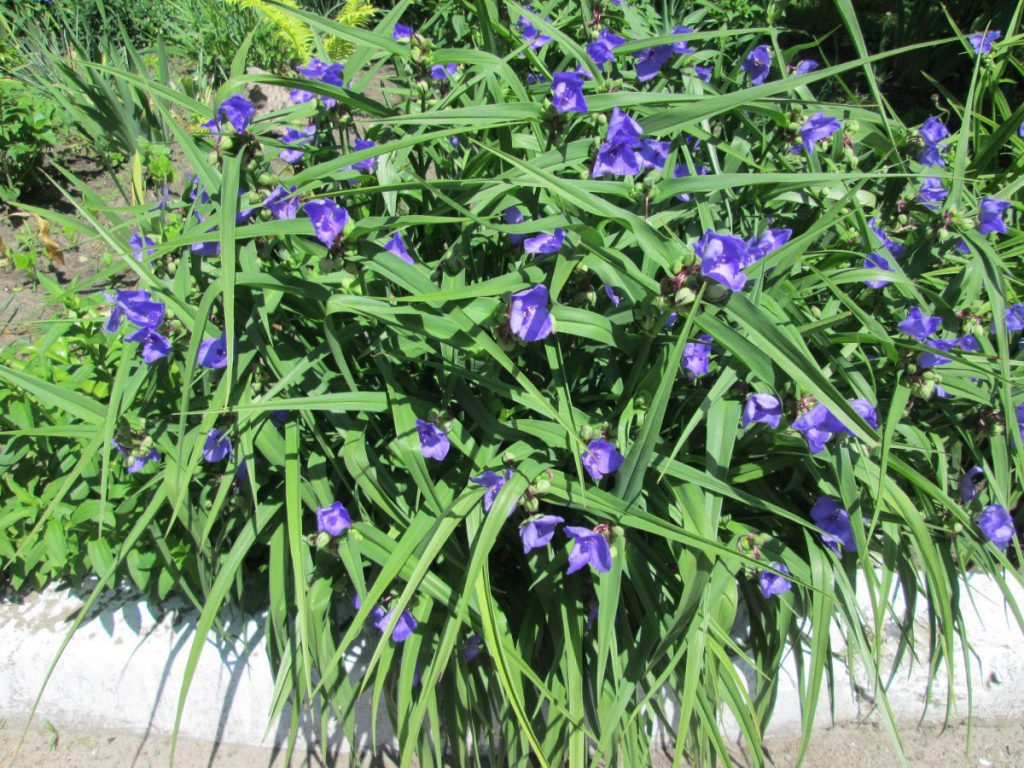
Tradescantia garden perennial
- planted singly or in groups - along water bodies, in flower beds, alpine slides, in mixborders;
- several varieties, planted along the curbs, garden paths, look beautiful;
- goes well in a flower garden with tall and medium-sized decorative deciduous plants.
Description of varieties
There are several subspecies that you can distinguish from the detailed description.
Anderson
This species was bred on the basis of Virginia Tradescantia and wild varieties. The hybrid form is suitable for a shady garden, because in the sun it quickly fades and dries out.
The size is small - 30-35 cm. In the lower part of the erect stems, long, belt-like leaves of a rich green color develop.
Inflorescences are formed at the top of the shoots.Small (circumference 3-4 cm), three-lobed, blue tone.
The main advantage of the variety is its high frost resistance (it can withstand temperatures as low as -34 ° C). Therefore, it is suitable for cultivation in all climatic zones of our country.
Rosy bride
A very beautiful bush plant up to 50 cm high with dense branching. Along the entire length, the stems are covered with oval, bronze leaves, pointed at the tips.

Tradescantia garden long-term planting and care photo
Flowers bloom at the tops of the shoots, consist of purple petals, closer to the core, the color becomes dark purple.
Wegelin
Another attractive variety with blue inflorescences, which is readily used in landscape design. The height of the stems is 50 cm, the foliage is good.
The leaves are green, elongated, belt-like, densely cover the lower part of the shoots, forming a dense and lush bush.
In addition to decorative qualities, the flower has other advantages:
- good frost resistance;
- long flowering - from early summer to late autumn;
- good immunity against diseases, pests.
Charm mix
Many people love this variety for its unpretentiousness to the soil, climate - they successfully take root in any area.
There are several hybrid forms that differ in the color of the inflorescences - snow-white, pink, blue or blue. The flowers are small, three-lobed.
The variety also has other advantages - it is rarely damaged by diseases, pests, it tolerates severe winters well.
Virginia
The second name is street. One of the most favorite varieties among summer residents. The plant is bushy, consists of many shoots, densely covered with foliage and inflorescences at the crown.
The variety has a strong immunity to disease.
Pleases with small three-lobed flowers of light lilac color. Light pubescence with yellow stamens in the center.
Striped
The description includes several distinguishing characteristics:
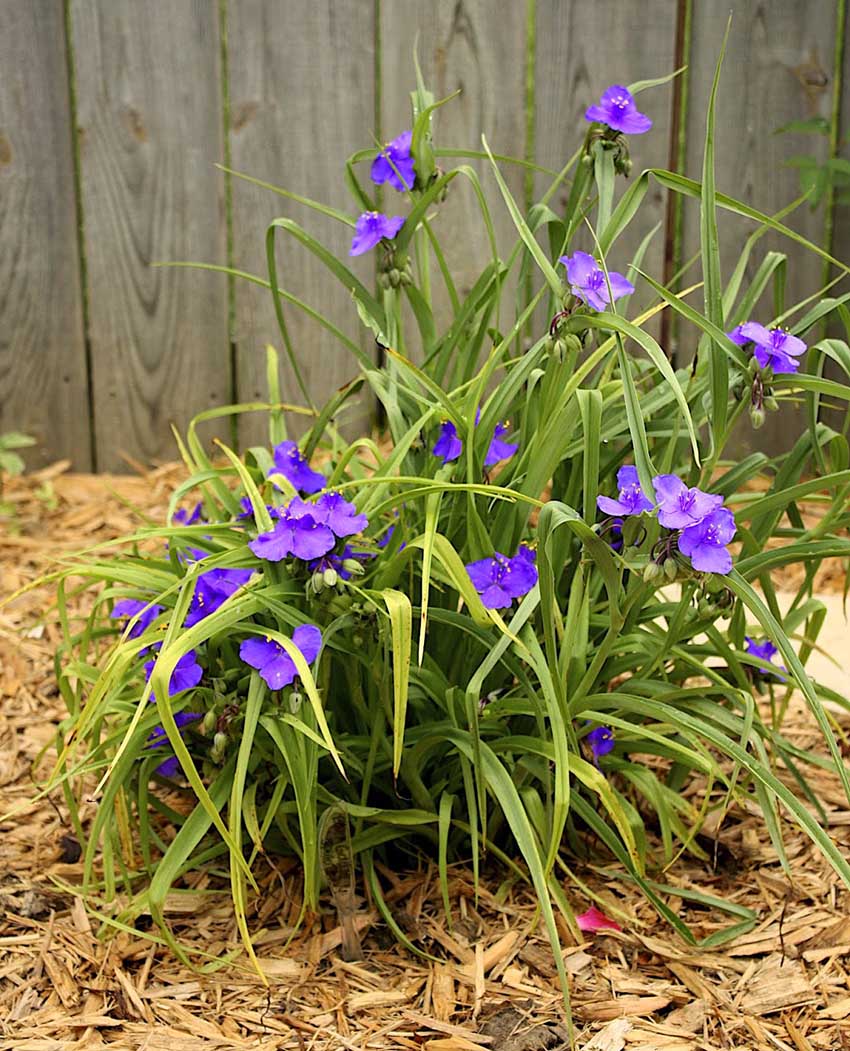
Tradescantia garden perennial planting and care
- high growth - about 80 cm;
- leaves are long, alternate;
- inflorescences are three-petal, there are different colors - lilac, violet or pink.
Bilberry ice
Hybrid form with original color of buds - crimson petals with a white border around the edge.
Leaves are long, belt-like, bright green. Stems are erect, height 40-50 cm.
Giant
This garden variety prefers to grow on rocky ground, so it is often used to create rockeries, alpine slides, and rabatok.
Despite this name, the bush is small in size - the maximum height is about 40 cm. The leaves are green, wide, sepals with double pubescence.
Long-rhizome
Miniature plant up to 10 cm high. Flower arrows are small, thin, form blue or pink inflorescences at the tops.
This variety is considered very hardy and can develop fully in the driest areas.
Ohio
Tradescantia is gigantic in size - the height can reach 1.2 m. The stems are covered with a light white bloom. The inflorescences are beautiful - they consist of three-lobed white, light blue or pink petals. The circumference of the flowers is 3-4 cm.
Ernestian
Another tall species - the length of the stems can grow up to 1 m. Flowers of a rich dark purple or burgundy tone, bloom in the spring and retain their decorative effect for 1.5-2 months.
Bracts
A compact bushy plant with smooth shoots 60-65 cm high. Floral arrows contain slight pubescence. Inflorescences are pink or blue, with fleecy petals.
Purchase and adaptation
You can buy all varieties of this crop at a gardening store or order seeds online.
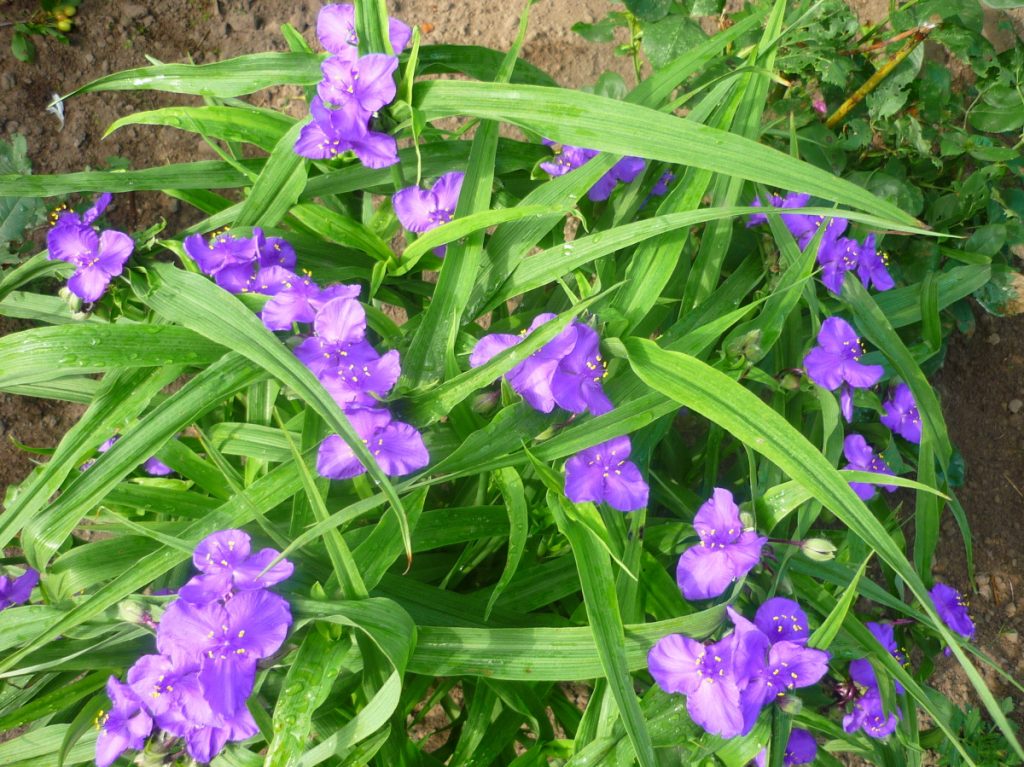
Tradescantia garden species and varieties with photos
When choosing seedlings in a pot, you should pay attention to their condition in order to get a luxuriantly blooming perennial shrub in the future.
In healthy bushes, leaves and stems are juicy, not yellowed, do not contain any spots, growths of black, brown color.
It is better to buy specimens with opened buds - this way you can make sure that this is a real variety. Blooming Tradescantia is another sign of vitality.
Immediately after the purchase, you should not transplant the plant, you need to give it a little time to adapt.
For 20 days of exposure in a separate room, you can determine whether it is sick with something or not. If you find signs of disease or pests, it is necessary to treat with fungicides or insecticides, respectively. After a week, you can move them to a common room with other colors.
Landing
Usually, planting is carried out in the spring, when the soil warms up to 10-12 ° С, and the street heat stabilizes at around 15 ° С.
The site is freed from garden debris and last year's vegetation. If necessary, add a deoxidizer. Sprinkle with humus (1 bucket), superphosphate (100 g) and potassium sulfate (70 g) per 1 m². Then they dig it up, level it, water it.
After two weeks, the planting holes are pulled out at a distance of 50 cm with a distance in a row of 70 cm. The dimensions of the holes should be slightly larger than the root ball.
Spill abundantly with water. They lower the root system, cover it with garden soil, moisten it again. To avoid moisture evaporation, mulch with rotted manure or garden soil.
To prevent the seedlings from withering and burning, the first week they are protected from the scorching sun - they are covered with burlap or agrofibre. Water every other day for 14 days so that they take root faster.
Growing conditions
It is a sun-loving plant that should be planted in a sunny location protected from drafts. At lunchtime, shading is required from the scorching sun, otherwise its foliage and inflorescences will quickly burn.
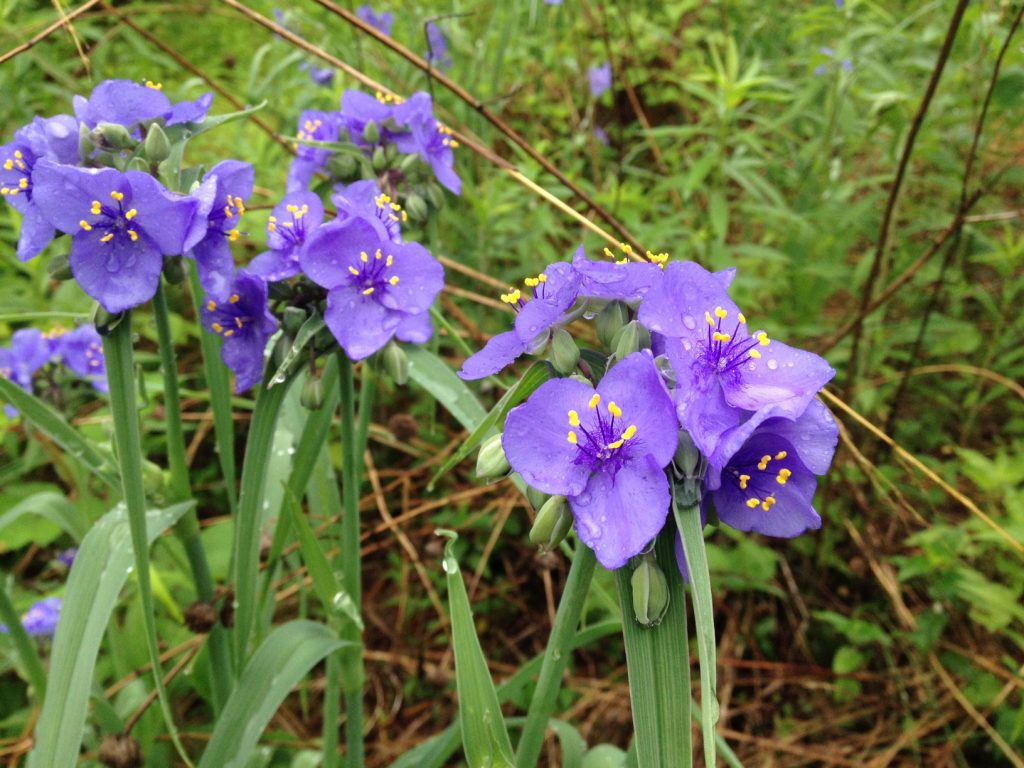
Tradescantia garden perennial photo
Better to plant among tall shrubs, under spreading trees, where there is partial shade at midday. It is important that the bush receives light in the morning and evening. If it is planted in the shade, where there is no diffused daylight, you should not expect flowering in the future.
The soil prefers light, loose, enriched with mineral and organic components. It grows poorly on acidified soil, so if the acidity level exceeds 6 units, it is necessary to add a deoxidizer (dolomite flour, slaked lime and had) - for 1 m² 400 g.
Humidity
The plant prefers moderate air humidity. On hot summer days, it responds positively to frequent spraying with warm water in the early morning or evening when the sun goes down. Closer to autumn, irrigation is stopped.
If you grow this plant at home, you need to provide it with fresh air in the fall and winter. Set up regular ventilation for 30 minutes. At the time of opening the window, it is advisable to take the flower to another room, because it does not tolerate drafts and can wither from sudden temperature changes.
Lighting
Prefers diffused daylight - 7-8 hours a day is enough. During the growing season, this requirement is provided by the sun's rays.
When grown at home, the flower is kept on the windowsills from the south or southwest side. In autumn and winter, they are supplemented with a fluorescent lamp. The device is installed at a distance of 50-60 cm from the crown.
Temperature
The optimum temperature is 20-25 ° C. Species that are weak to frost are insulated - they are spudded with garden soil, covered with burlap.
When kept at home, it grows fully at room temperature. In winter, when the dormant period begins, the flower can be transferred to a cooler place (12-15 ° C).
Care
Garden perennial tradescantia will delight with decorativeness if it is properly planted and provided with proper care in the future.

Tradescantia garden care
Watering
Humidification throughout the growing season should be regular and moderate. Watering every three days, taking into account seasonal precipitation.
- In a rainy summer, they should be discarded.
- In autumn and winter, the frequency is reduced - up to 2-3 times a month.
After the procedure, surface loosening of the soil is carried out, which helps to maintain its moisture and air permeable qualities.
Use warm water to avoid hypothermia and rotting of the root system.
Top dressing
This culture is not demanding on the fertility of the soil, so it can be fed only 2-3 times per season.
- The first feeding is carried out in the spring, as soon as new leaves appear - they are fertilized with universal mineral preparations for decorative flowering plants.
- The second time potash fertilizers are introduced into the budding phase.
- Last time - in the fall, a month before the onset of cold weather, they mulch with last year's manure.
Each root dressing is combined with watering to ensure high-quality and fast absorption of nutrients.
Pruning
Almost all types of garden tradescantia develop a beautiful and compact crown shape, so they do not need correction of the aerial part.
Throughout the growing season, a sanitary haircut will be required - dried, yellowed, decayed and damaged organs are cut out.
A well-sharpened and sterile secateurs are used for trimming. After the procedure, the crown can be sprayed with Epin or Zircon, so that the plant recovers faster.
Preparation for wintering
One of the important steps in the care, which will ensure a safe wintering and plant health in the open field.
A month before the onset of cold weather, the entire above-ground part is cut off, then covered with moss, spud with peat or last year's manure. When grown in the northern zone, they are additionally covered with spruce branches or other insulation.
Transfer
A perennial herb needs replanting regularly - every three years. A change in the place of growth and development is necessary, since over time the land is depleted and the flowers lose their original decorative effect.
You also need to transplant purchased specimens - the soil in which they were sold is not suitable for further cultivation. This procedure is started only after the plant has faded.
An unscheduled transplant is required for tradescantia with rotten roots from overflows or damaged diseases or pests.
The transplant technique is as follows:
- spill abundantly with water;
- an hour after watering, they are removed;
- together with an earthen lump, they are transferred to a new habitat.
During transplantation of a diseased plant, it is necessary to wash off all the soil from the roots, cut off all damaged areas to healthy tissue, treat with a fungicide, dry and transplant.
Reproduction methods
An ornamental-flowering culture propagates in several ways. Each of them has pros and cons.

Garden Tradescantia in landscape design
Cuttings
They are harvested in spring or summer. The apical shoots with several internodes are cut from a healthy bush. Leaves are cut off at the bottom. They are planted in well-moistened sandy soil. Cover with foil, periodically moisten, ventilate.
After about 10 days, when they are rooted, they are transplanted into a shaded area in the garden for further growing. You can plant seedlings in a flower garden at the end of summer.
Seeds
Sowing seeds is carried out in winter in a light peat-sandy soil to a depth of 2 cm. Then the seedlings are sprayed, covered with a film, and put in a warm place. Until the moment of germination, they are periodically irrigated with warm water and ventilated. With a massive emergence of seedlings, the shelter is removed. They continue to grow until spring. At the stage of development, one pair of leaves dive into separate containers.
You can transplant it into open ground when the soil warms up well and the threat of recurrent frosts has passed.
By dividing the bush
Usually this method is relevant for old bushes that need rejuvenation. In spring or autumn, the flower is watered abundantly, dug out, washed off the remnants of the soil, divided into parts so that each has one stem with leaves and 2-3 roots. Places of cuts are sprinkled with charcoal. They are seated in separate holes, moistened, mulched with peat.
Diseases and pests
Infection with infections and parasites is possible only if the rules of agricultural technology are violated.
| Pests and diseases | Signs | Treatment | Prophylaxis |
| Spider mite, scale insect, aphid, mealybug | These parasites feed on the sap of leaves, young shoots and buds. Lead to their yellowing and withering away | Insecticide treatment - Aktellik, Aktara, Fundazol or Karbofos | Regularly inspect for damage, loosen the soil, apply top dressing on time, spill the soil before planting with fungicides |
| Root rot | From frequent overflows of cold water, first the root rots, then the stems in the lower part acquire a black bloom, become soft | It is difficult to save the plant, so it is disposed of. Cut 2-3 cuttings for further rooting | Observe the watering regime, moisten with warm water |
Healing properties
Almost all types of garden tradescantia are in great demand in folk and traditional medicine:

Tradescantia garden in landscape design photo
- have a hemostatic and wound healing effect;
- alcohol tincture on leaves and stems is used in the treatment of gastrointestinal diseases, colds and tuberculosis;
- leaf juice helps to get rid of periodontal disease.

